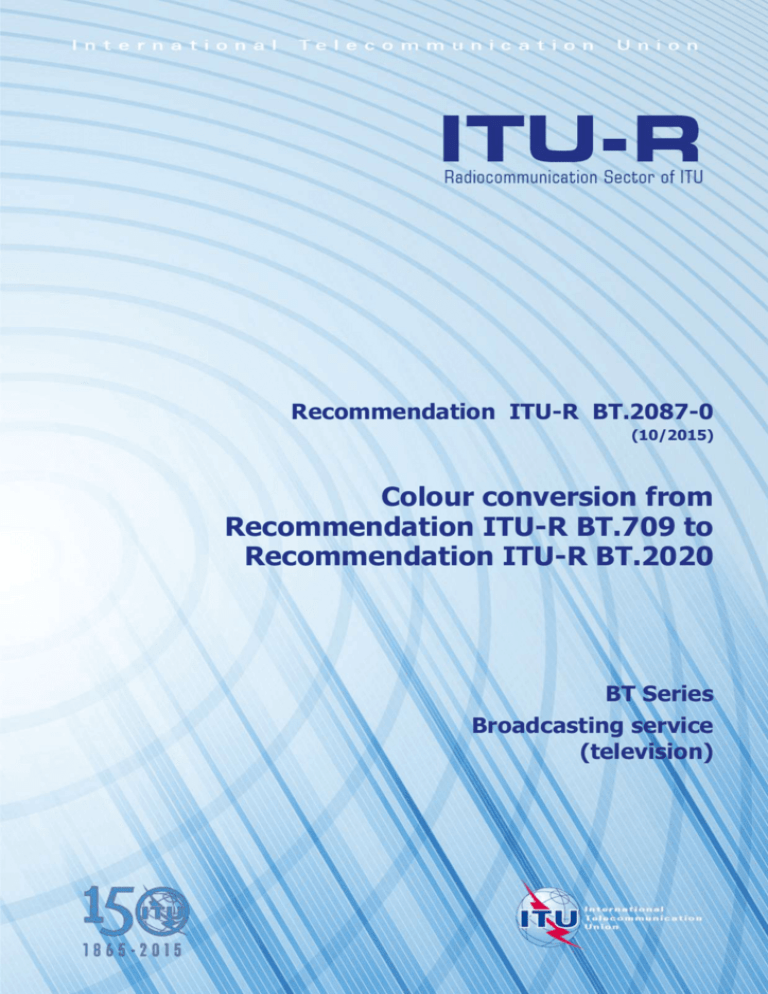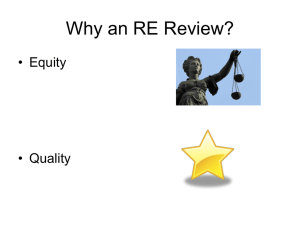
Recommendation ITU-R BT.2087-0
(10/2015)
Colour conversion from
Recommendation ITU-R BT.709 to
Recommendation ITU-R BT.2020
BT Series
Broadcasting service
(television)
ii
Rec. ITU-R BT.2087-0
Foreword
The role of the Radiocommunication Sector is to ensure the rational, equitable, efficient and economical use of the radiofrequency spectrum by all radiocommunication services, including satellite services, and carry out studies without limit
of frequency range on the basis of which Recommendations are adopted.
The regulatory and policy functions of the Radiocommunication Sector are performed by World and Regional
Radiocommunication Conferences and Radiocommunication Assemblies supported by Study Groups.
Policy on Intellectual Property Right (IPR)
ITU-R policy on IPR is described in the Common Patent Policy for ITU-T/ITU-R/ISO/IEC referenced in Annex 1 of
Resolution ITU-R 1. Forms to be used for the submission of patent statements and licensing declarations by patent holders
are available from http://www.itu.int/ITU-R/go/patents/en where the Guidelines for Implementation of the Common
Patent Policy for ITU-T/ITU-R/ISO/IEC and the ITU-R patent information database can also be found.
Series of ITU-R Recommendations
(Also available online at http://www.itu.int/publ/R-REC/en)
Title
Series
BO
BR
BS
BT
F
M
P
RA
RS
S
SA
SF
SM
SNG
TF
V
Satellite delivery
Recording for production, archival and play-out; film for television
Broadcasting service (sound)
Broadcasting service (television)
Fixed service
Mobile, radiodetermination, amateur and related satellite services
Radiowave propagation
Radio astronomy
Remote sensing systems
Fixed-satellite service
Space applications and meteorology
Frequency sharing and coordination between fixed-satellite and fixed service systems
Spectrum management
Satellite news gathering
Time signals and frequency standards emissions
Vocabulary and related subjects
Note: This ITU-R Recommendation was approved in English under the procedure detailed in Resolution ITU-R 1.
Electronic Publication
Geneva, 2015
ITU 2015
All rights reserved. No part of this publication may be reproduced, by any means whatsoever, without written permission of ITU.
Rec. ITU-R BT.2087-0
1
RECOMMENDATION ITU-R BT.2087-0
Colour conversion from Recommendation ITU-R BT.709 to
Recommendation ITU-R BT.2020
(2015)
Scope
This Recommendation addresses a method of colour conversion from Recommendation ITU-R BT.709 to
Recommendation ITU-R BT.2020 for use when HDTV programme content is included within UHDTV
programmes. Two sets of conversion equations are specified. One set is based on an opto-electronic transfer
function (OETF) and its inverse. The other set is based on an electro-optical transfer function (EOTF) and its
inverse.
Keywords
UHDTV, colour conversion
The ITU Radiocommunication Assembly,
considering
a)
that Recommendation ITU-R BT.2020 – Parameter values for ultra-high definition television
systems for production and international programme exchange, specifies the parameter values for the
UHDTV image systems, and one of the features of UHDTV is its colour gamut wider than that of
HDTV as specified in Recommendation ITU-R BT.709;
b)
that an increasing number of television broadcasters and programme makers around the world
are starting to produce UHDTV programmes;
c)
that HDTV programmes may well be used for making UHDTV programmes, which
necessitates colour conversion from Recommendation ITU-R BT.709 to Recommendation
ITU-R BT.2020;
d)
that it is required that colours of Recommendation ITU-R BT.709 content should be
unchanged by the colour conversion to Recommendation ITU-R BT.2020 and that the conversion
method should be mathematically definable,
recommends
1
that when colour conversion from Recommendation ITU-R BT.709 to Recommendation
ITU-R BT.2020 is required for UHDTV programme production and international exchange, the
method described in Annex 1 should be used.
2
Rec. ITU-R BT.2087-0
Annex 1
Method for colour conversion from Recommendation ITU-R BT.709
to Recommendation ITU-R BT.2020
Figure 1 shows a block diagram of the colour conversion from Recommendation ITU-R BT.709
(Rec. 709) to the non-constant luminance signal format in Table 4 of Recommendation ITU-R
BT.2020 (Rec. 2020). The input and output of this diagram are digitally represented Y′C′BC′R signals
or R′G′B′ signals.
FIGURE 1
Block diagram of colour conversion from Rec. 709 Y′C′BC′R or R′G′B′ to Rec. 2020 Y′C′BC′R or R′G′B′
for the non-constant luminance signal format in Recommendation ITU-R BT.2020
D'YD'CB D'CR
E' YE' CBE' CR
QYC-1
709
D'RD' GD' B
709
E' RE'G E' B
E'RE' G E' B
M1
E' RE' G E'B
M2
709
709
E REG EB
709
E' YE' CB E'CR
Q YC
M3
2020
2020
2020
Q RGB
QRGB -1
D' YD'CB D'CR
2020
D' RD'G D' B
2020
BT.2087-01
The functions and equations of each block in Fig. 1 are as follows:
QYC-1
Inverse-quantisation of digitally represented luminance and colour-difference signals D′YD′CBD′CR
(Rec. 709) in the bit-depth of N709 bits to normalized luminance and colour-difference signals
E′YE′CBE′CR (Rec. 709):
𝐸 ′ 𝑌 = (𝐷′ 𝑌 ⁄2𝑁709 −8 − 16)⁄219
𝐸 ′ 𝐶𝐵 = (𝐷′ 𝐶𝐵 ⁄2𝑁709 −8 − 128)⁄224
𝐸 ′ 𝐶𝑅 = (𝐷′ 𝐶𝑅 ⁄2𝑁709 −8 − 128)⁄224
QRGB-1
Inverse-quantisation of digitally represented colour signals D′RD′GD′B (Rec. 709) in the bit-depth of
N709 bits to normalized colour signals E′RE′GE′B (Rec. 709):
𝐸 ′ 𝑅 = (𝐷′ 𝑅 ⁄2𝑁709−8 − 16)⁄219
𝐸 ′ 𝐺 = (𝐷′ 𝐺 ⁄2𝑁709 −8 − 16)⁄219
𝐸 ′ 𝐵 = (𝐷′ 𝐵 ⁄2𝑁709 −8 − 16)⁄219
M1
Conversion from normalized luminance and colour-difference signals E′YE′CBE′CR (Rec. 709) to
normalized R′G′B′ colour signals E′RE′GE′B (Rec. 709):
Rec. ITU-R BT.2087-0
3
1
0
1.5747
𝐸′𝑌
𝐸′𝑅
𝐸′𝐺 = [1 −0.1873 −0.4682] 𝐸′𝐶𝐵
′
′
1 1.8556
0
[𝐸𝐵 ]
[𝐸𝐶𝑅 ]
Non-linear to linear conversion from normalized R′G′B′ colour signals E′RE′GE′B (Rec. 709) to
linearly represented, normalized RGB colour signals EREGEB (Rec. 709) is accomplished by one of
two equations which produce slightly different colours from each other:
Case #1: In the case where the goal is to preserve colours seen on a Rec. 709 display1 when displayed
on a Rec. 2020 display2, an approximation of the electro-optical transfer function (EOTF) from
Recommendation ITU-R BT.1886 (Rec. 1886) is used:
𝐸 = (𝐸′)2.40
, 0 ≤ 𝐸′ ≤ 1
Case #2: In the case where the source is a direct camera output and the goal is to match the colours
of a direct Rec. 2020 camera output, an approximation of the Rec. 709 inverse opto-electronic transfer
function (OETF) is used (see Annex 2):
𝐸 = (𝐸′)2
, 0 ≤ 𝐸′ ≤ 1
NOTE 1: Recommendation ITU-R BT.1886 specifies the reference EOTF which is used to display Rec. 709
signals. This transfer function is expressed as L = a(max[(V+b),0])2.40; where a =(LW1/2.40–LB1/2.40)2.40 and
b = LB1/2.40/(LW1/2.40–LB1/2.40). The approximated, normalized form of this transfer function is shown in this
document, which is found by setting LW = 1 and LB = 0.
NOTE 2 – The range of E or E' is defined within the range of 0 to 1 in Recommendation ITU-R BT.709.
However, the definition of the video signal quantization allows values above 1 or below 0. The above equation
may also be applied to those values above 1 or below 0.
1
A Rec. 709 display is a display device with RGB primaries that correspond to those in Recommendation
ITU-R BT.709, a D65 white point, and an EOTF which conforms to Recommendation ITU-R BT.1886.
2
A Rec. 2020 display is a display device with RGB primaries that correspond to those in Recommendation
ITU-R BT.2020, a D65 white point, and an EOTF which conforms to Recommendation ITU-R BT.1886.
4
Rec. ITU-R BT.2087-0
M2
Colour conversion from linearly represented, normalized RGB colour signals EREGEB (Rec. 709) to
linearly represented, normalized RGB colour signals EREGEB (Rec. 2020):
𝐸𝑅
0.6370 0.1446 0.1689 −1 0.4124 0.3576 0.1805 𝐸𝑅
[𝐸𝐺 ]
= [0.2627 0.6780 0.0593] [0.2126 0.7152 0.0722] [𝐸𝐺 ]
𝐸𝐵 2020
0
0.0281 1.0610
0.0193 0.1192 0.9505 𝐸𝐵 709
1.7167 −0.3557 −0.2534 0.4124 0.3576 0.1805 𝐸𝑅
= [−0.6667 1.6165
0.0158 ] [0.2126 0.7152 0.0722] [𝐸𝐺 ]
0.0176 −0.0428 0.9421 0.0193 0.1192 0.9505 𝐸𝐵 709
0.6274 0.3293 0.0433 𝐸𝑅
= [0.0691 0.9195 0.0114] [𝐸𝐺 ]
0.0164 0.0880 0.8956 𝐸𝐵 709
Linear to non-linear conversion from linearly represented, normalized RGB colour signals EREGEB
(Rec. 2020) to normalized R′G′B′ colour signals E′RE′GE′B (Rec. 2020) is accomplished by applying
the inverse of the non-linear to linear conversion equation.
Case #1: In the cases where the goal is to preserve colours seen on a Rec. 709 display, an
approximation of the Rec. 1886 inverse EOTF is used:
𝐸 ′ = 𝐸 1⁄2.40
,
0≤𝐸≤1
Case #2: In the case where the source is a direct camera output and the goal is to match the colours
of a direct Rec. 2020 camera output, an approximation of the Rec. 2020 OETF is used (see Annex 2):
𝐸 ′ = 𝐸 1⁄2
,
0≤𝐸≤1
NOTE 3: The range of E or E' is defined within the range of 0 to 1 in Recommendation ITU-R BT.2020.
However, the definition of the video signal quantization allows values above 1 or below 0. The above equation
may also be applied to those values above 1 or below 0.
M3
Conversion from normalized R′G′B′ colour signals E′RE′GE′B (Rec. 2020) to normalized luminance
and colour-difference signals E′YE′CBE′CR (Rec. 2020):
0.2627
𝐸𝑌′
′
[𝐸𝐶𝐵
] = [−0.1396
′
𝐸𝐶𝑅
0.5000
0.6780
−0.3604
−0.4598
0.0593
𝐸𝑅′
0.5000 ] [𝐸𝐺′ ]
𝐸𝐵′
−0.0402
Rec. ITU-R BT.2087-0
5
QRGB
Quantisation of normalized colour signals E′RE′GE′B (Rec. 2020) to digitally represented colour
signals D′RD′GD′B (Rec. 2020) in the bit-depth of N2020 bits:
𝐷′ 𝑅 = INT[(219 × 𝐸 ′ 𝑅 + 16) × 2𝑁2020 −8 ]
𝐷′ 𝐺 = INT[(219 × 𝐸 ′ 𝐺 + 16) × 2𝑁2020 −8 ]
𝐷′ 𝐵 = INT[(219 × 𝐸 ′ 𝐵 + 16) × 2𝑁2020−8 ]
QYC
Quantisation of normalized luminance and colour-difference signals E′YE′CBE′CR (Rec. 2020) to
digitally represented luminance and colour-difference signals D′YD′CBD′CR (Rec. 2020) in the
bit-depth of N2020 bits:
𝐷′ 𝑌 = INT[(219 × 𝐸 ′ 𝑌 + 16) × 2𝑁2020 −8 ]
𝐷 ′ 𝐶𝐵 = INT[(224 × 𝐸 ′ 𝐶𝐵 + 128) × 2𝑁2020−8 ]
𝐷 ′ 𝐶𝑅 = INT[(224 × 𝐸 ′ 𝐶𝑅 + 128) × 2𝑁2020 −8 ].
Figure 2 shows a block diagram for the colour conversion from Rec. 709 to the constant luminance
signal format in Table 4 of Recommendation BT.2020. The input signals of this diagram are digitally
represented R′G′B′ and Y′C′BC′R. And the output signals are digitally represented R′G′B′ and
Y′CC′BCC′RC where the addition of the ‘c’ subscript indicates the constant luminance signal format.
FIGURE 2
Block diagram of colour conversion from Rec. 709 Y′C′BC′R or R′G′B′ to Rec. 2020
Y′CC′BCC′RC or R′G′B′ for the constant luminance signal format in Recommendation ITU-R BT.2020
D' YD' CBD' CR
E' Y E' CBE' CR
QYC
709
-1
E' RE' G E'B
E REGE B
M1
EREG EB
E' YCE' RE' B
M2
709
709
E' YCE' CBCE' CRC
Q YC
C
2020
2020
D'YC D'CBC D'CRC
2020
2020
EYC
D'RD' G D'B
709
Q RGB
-1
M4
D' RD'G D'B
QRG
2020
BT.2087-02
The functions and equations of each block in Fig. 2 are as follows:
For the five blocks inside the black broken line, the same equations and input/output signals are
applied as in the descriptions for Fig. 1. These blocks correspond to the conversion from the digitally
represented luminance and colour-difference D′YD′CBD′CR and colour D′RD′GD′B signals (Rec. 709) to
the linearly represented, normalized RGB colour signals EREGEB (Rec. 2020).
6
Rec. ITU-R BT.2087-0
For the ‘M4’ and ‘C’ blocks in Fig. 2 (for the constant luminance signal format) are different
compared with the blocks in Fig. 1 (for the non-constant luminance signal format). The same
non-linear function and quantization equations are applied for
, ‘QYcCc’ and ‘QRGB’ blocks. To
differentiate between the non-constant and constant signal format, the ‘c’ subscript is added for the
constant luminance signal format.
M4
Conversion from linearly represented, normalized RGB colour signals EREGEB (Rec. 2020) to
normalized constant-luminance signal EYc (Rec. 2020):
[𝐸𝑌𝑐 ] = [0.2627
0.6780
𝐸𝑅
]
[
0.0593 𝐸𝐺 ]
𝐸𝐵
Linear to non-linear conversion from linearly represented, normalized RB colour signals EREB and
normalized constant-luminance signal EYc (Rec. 2020) to non-linearly represented, normalized R′B′
colour signals E′RE′B and normalized constant-luminance signal E′Yc (Rec. 2020) is accomplished by
applying the inverse of the non-linear to linear conversion equation.
Case #1: In the case where the goal is to preserve colours seen on a Rec. 709 display when displayed
on a Rec. 2020 display, an approximation of the Rec. 1886 inverse EOTF is used:
𝐸 ′ = 𝐸 1⁄2.40
,
0≤𝐸≤1
Case #2: In the case where the source is a direct camera output and the goal is to match the colours
of a direct Rec. 2020 camera output, an approximation of the Rec. 2020 OETF is used (see Annex 2):
𝐸 ′ = 𝐸 1⁄2
,
0≤𝐸≤1
NOTE 4: The range of E or E' is defined within the range of 0 to 1 in Recommendation ITU-R BT.2020.
However, the definition of the video signal quantization allows values above 1 or below 0. The above equation
may also be applied to those values above 1 or below 0.
C
Conversion from non-linearly represented, normalized R′B′ colour signals E′RE′B and normalized
constant-luminance signal E′Yc (Rec. 2020) to normalized colour-difference signals E′CBcE′CRc
(Rec. 2020):
𝐸 ′ 𝐵 − 𝐸 ′ 𝑌𝑐
, −0.9702 ≤ 𝐸 ′ 𝐵 − 𝐸 ′ 𝑌𝑐 ≤ 0
2
×
0.9702
′
𝐸 𝐶𝐵𝑐 =
𝐸 ′ 𝐵 − 𝐸 ′ 𝑌𝑐
′
′
{2 × 0.7910 , 0 < 𝐸 𝐵 − 𝐸 𝑌𝑐 ≤ 0.7910
Rec. ITU-R BT.2087-0
𝐸 ′ 𝐶𝑅𝑐
7
𝐸 ′ 𝑅 − 𝐸 ′ 𝑌𝑐
, −0.8591 ≤ 𝐸 ′ 𝑅 − 𝐸 ′ 𝑌𝑐 ≤ 0
2
×
0.8591
=
𝐸 ′ 𝑅 − 𝐸 ′ 𝑌𝑐
′
′
{2 × 0.4969 , 0 < 𝐸 𝑅 − 𝐸 𝑌𝑐 ≤ 0.4969
QRGB
Quantisation of normalized colour signals E′RE′GE′B (Rec. 2020) to digitally represented colour
signals D′RD′GD′B (Rec. 2020) in the bit-depth of N2020 bits:
𝐷′ 𝑅 = INT[(219 × 𝐸 ′ 𝑅 + 16) × 2𝑁2020 −8 ]
𝐷′ 𝐺 = INT[(219 × 𝐸 ′ 𝐺 + 16) × 2𝑁2020 −8 ]
𝐷′ 𝐵 = INT[(219 × 𝐸 ′ 𝐵 + 16) × 2𝑁2020−8 ]
QYcCc
Quantisation of normalized constant-luminance and colour-difference signals E′YcE′CBcE′CRc
(Rec. 2020) to digitally represented constant-luminance and colour-difference signals D′YcD′CBcD′CRc
(Rec. 2020) in the bit-depth of N2020 bits:
𝐷 ′ 𝑌𝑐 = INT[(219 × 𝐸 ′ 𝑌𝑐 + 16) × 2𝑁2020 −8]
𝐷 ′ 𝐶𝐵𝑐 = INT[(224 × 𝐸 ′ 𝐶𝐵𝑐 + 128) × 2𝑁2020 −8 ]
𝐷 ′ 𝐶𝑅𝑐 = INT[(224 × 𝐸 ′ 𝐶𝑅𝑐 + 128) × 2𝑁2020 −8 ]
Annex 2 (informative)
Non-linear transfer functions for colour conversion
A concept of signal flow from scene light to display light in video systems is modelled as shown in
Fig. 3, consisting of four functions: camera adjustments for creative rendering, opto-electronic
transfer function (OETF), electro-optical transfer function (EOTF), and display adjustments to
compensate for viewing environment.
Camera adjustments include linear segment near black, pre-knee, knee point, knee slope, and other
adjustments. The Rec. 709 and Rec. 2020 OETFs are similar to a square root function. The deviation
of these OETFs from a 1/2.0-power function including the linear segment near black can be
decomposed into the camera adjustment function. So the OETF itself can be regarded as a square root
function.
On the basis of this concept, the square function and square root function should be used for the
conversion between linear and non-linear signal representations for the Case #2 OETF-based
conversion.
8
Rec. ITU-R BT.2087-0
FIGURE 3
Block diagram of OETF and EOTF in video systems
Scene light
Camera
adjustments
OETF
Image data
EOTF
Display
adjustments
Display light
BT.2087-03
Annex 3 (informative)
Examples of the two use cases for colour conversion
As described in Annex 1, there are two general use cases where colour conversion from Rec. 709 to
Rec. 2020 is desired. In the first use case (Case #1), the goal is to preserve colours originally seen on
a Rec. 709 display on a Rec. 2020 display. Note that a Rec. 709 display is a display device with RGB
primaries that correspond to those in Recommendation ITU-R BT.709, a D65 white point, and an
EOTF which conforms to Recommendation ITU-R BT.1886. Likewise, a Rec. 2020 display is a
display device with RGB primaries that correspond to those in Recommendation ITU-R BT.2020, a
D65 white point, and an EOTF which conforms to Recommendation ITU-R BT.1886. In the second
use case (Case #2), the goal is to match the colours of a direct Rec. 2020 camera output. The following
example is intended to illustrate the difference between the two cases, and the need for two different
conversion approaches.
For this example, a red object is captured by two different cameras: one of which conforms to the
Rec. 709 specification and the other conforms to the Rec. 2020 specification. The Rec. 709 camera
is connected to a Rec. 709 display, which is operating in a typical reference setup (Rec. 1886 EOTF
with a 100 cd/m2 white level, 0.005 cd/m2 black level, in a Rec. 2035 viewing environment).
Similarly, the Rec. 2020 camera is connected to a Rec. 2020 display, with the same reference setup
(Rec. 1886 EOTF with a 100 cd/m2 white level, 0.005 cd/m2 black level, in a Rec. 2035 viewing
environment).
The red object is selected to be at 20 cd/m2 luminance and the same chromaticity as the Rec. 709 red
primary. This can be expressed in Yxy coordinates as Y = 20, x = 0.64, y = 0.33.
If the Rec. 709 camera is assumed to have a sensor which utilizes perfect CIE1931 colour matching
functions, and the iris is adjusted so the red object produces a normalized Y output from the sensor
of 0.2, the result is a 10-bit Rec. 709 encoded R’G’B’ output of R’ = 914, G’ = 64, B’ = 64. After
being decoded by the Rec. 709 display, the result is an output of Y = 19.8, x = 0.640, y = 0.330 which
is very close to the original scene colour.
If the Rec. 2020 camera sensor is assumed to utilize the same colour matching functions and the same
iris setting, the result is a 10-bit Rec. 2020 encoded R’G’B’ output of R’ = 737, G’ = 258, B’ = 125.
The values are very different from the Rec. 709 camera output because the red colour is not near the
red primary of the Rec. 2020 system as it was with the Rec. 709 system. After being decoded by the
Rec. 2020 display the result is an output of Y = 16.2, x = 0.677, y = 0.316 which is slightly dimmer
and slightly more reddish than the original scene colour. This change is an effect of the system gamma
rendering taking place in a larger colour space.
Now if the Rec. 709 output of R’ = 914, G’ = 64, B’ = 64 is converted to Rec. 2020 with the Case #1
EOTF-based conversion, the result is a Rec. 2020 output of R’ = 764, G’ = 343, B’ = 217. After being
decoded by the Rec. 2020 display the result is an output of Y = 20.3, x = 0.634, y = 0.331 which is
very close to the original Rec. 709 display colour (a DeltaE2000 difference of 0.75). It is very different
from the Rec. 2020 capture and display colour (a DeltaE2000 difference of 5.9).
Rec. ITU-R BT.2087-0
9
If the Rec. 709 output of R’ = 914, G’ = 64, B’ = 64 is instead converted to Rec. 2020 with the Case #2
OETF-based conversion, the result is a Rec. 2020 output of R’ = 737, G’ = 287, B’ = 173. After being
decoded by the Rec. 2020 display the result is an output of Y = 17.0, x = 0.660, y = 0.321 which is a
better match than Case #1 to the original Rec. 2020 capture and display colour (a DeltaE2000
difference of 2.3). But it is a worse match to the original Rec. 709 display colour (a DeltaE2000
difference of 3.4).
So it seems clear that for converting pre-produced content, which was originally approved on a
Rec. 709 display, the Case #1 EOTF-based conversion can be preferred. But for mixing live outputs
of Rec. 709 and Rec. 2020 cameras, the Case #2 OETF-based conversion can be preferred.









